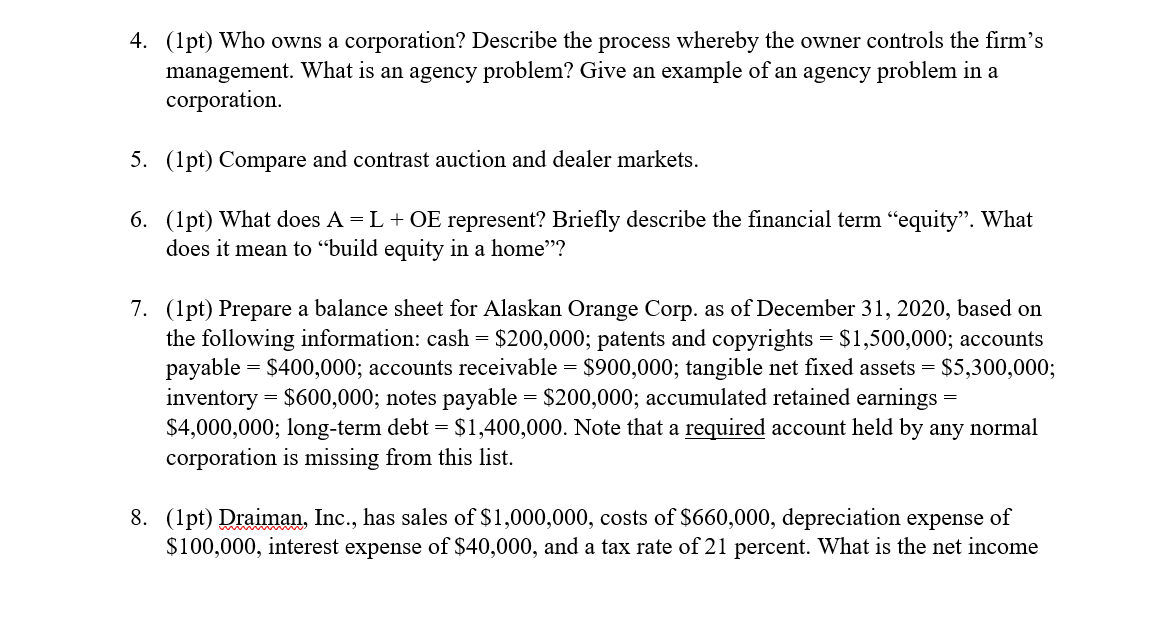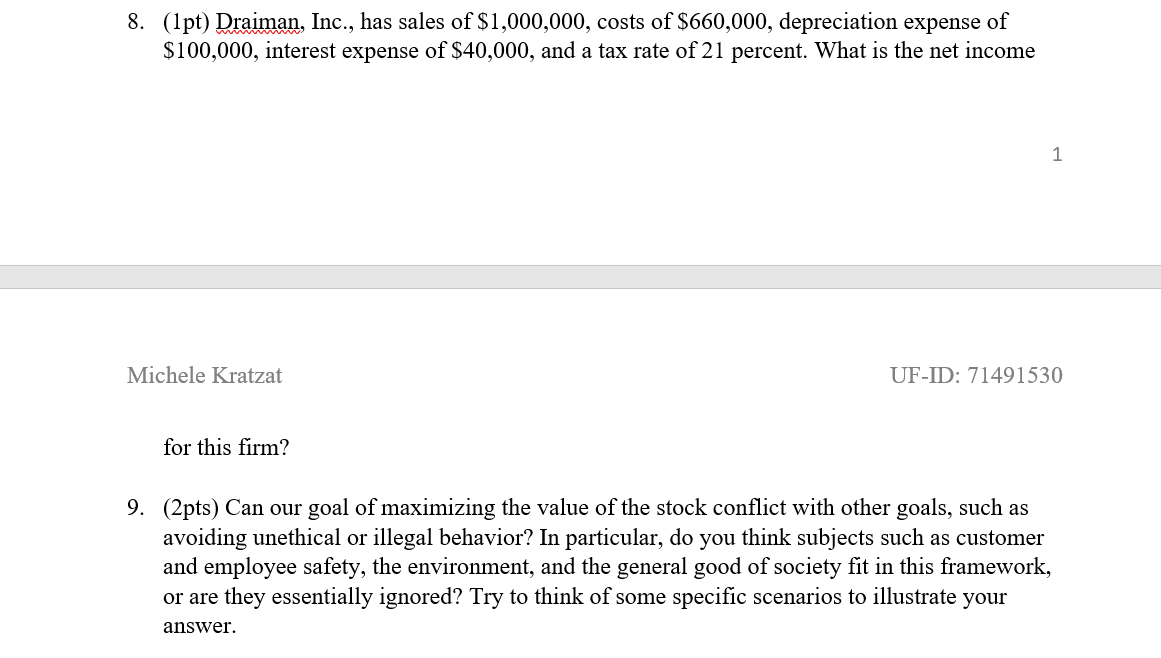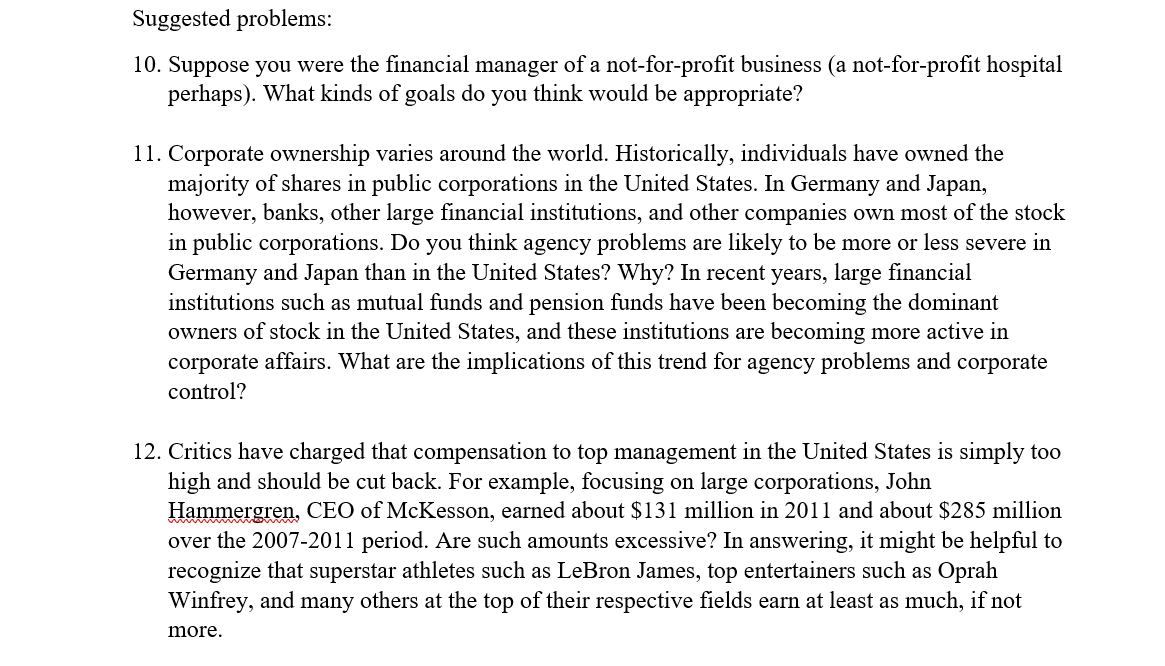




Homework #1 Due 1/27/21 Show your work for full credit 1. (1pt) What are the three types of financial management decisions? For each type of decision, give an example of a business transaction that would be relevant. a. Capital budgeting. When a farming cooperation purchases a tractor, the company must manage the tractor so that it can be useful until it compensates the financial loss incurred to purchase the tractor and the firm can make a profit off it. b. Capital (financial) structure. When a firm receives money from shareholders to operate the firm it is usually because the firm's equity or value is increasing. A firm increasing value means the firm itself and shareholders make a profit from the firm. c. Working capital management. When a newspaper company still owes their paper supplier the payment for the paper supply. 2. (1pt) Compare and contrast the three primary forms of business organization. How does a limited liability company (LLC) and S-Corp differ from a traditional corporation? a. 3. (1pt) What is the primary goal of a financial manager? How does this goal differ between businesses with and without stock? 4. (1pt) Who owns a corporation? Describe the process whereby the owner controls the firm's management. What is an agency problem? Give an example of an agency problem in a corporation. 5. (1pt) Compare and contrast auction and dealer markets. 6. (1pt) What does A = L + OE represent? Briefly describe the financial term "equity. What does it mean to build equity in a home? 7. (1pt) Prepare a balance sheet for Alaskan Orange Corp. as of December 31, 2020, based on the following information: cash = $200,000; patents and copyrights = $1,500,000; accounts payable = $400,000; accounts receivable = $900,000; tangible net fixed assets = $5,300,000; inventory = $600,000; notes payable = $200,000; accumulated retained earnings = $4,000,000; long-term debt = $1,400,000. Note that a required account held by any normal corporation is missing from this list. 8. (1pt) Draiman, Inc., has sales of $1,000,000, costs of $660,000, depreciation expense of $100,000, interest expense of $40,000, and a tax rate of 21 percent. What is the net income 8. (1pt) Draiman, Inc., has sales of $1,000,000, costs of $660,000, depreciation expense of $100,000, interest expense of $40,000, and a tax rate of 21 percent. What is the net income 1 Michele Kratzat UF-ID: 71491530 for this firm? 9. (2pts) Can our goal of maximizing the value of the stock conflict with other goals, such as avoiding unethical or illegal behavior? In particular, do you think subjects such as customer and employee safety, the environment, and the general good of society fit in this framework, or are they essentially ignored? Try to think of some specific scenarios to illustrate your answer. Suggested problems: 10. Suppose you were the financial manager of a not-for-profit business (a not-for-profit hospital perhaps). What kinds of goals do you think would be appropriate? 11. Corporate ownership varies around the world. Historically, individuals have owned the majority of shares in public corporations in the United States. In Germany and Japan, however, banks, other large financial institutions, and other companies own most of the stock in public corporations. Do you think agency problems are likely to be more or less severe in Germany and Japan than in the United States? Why? In recent years, large financial institutions such as mutual funds and pension funds have been becoming the dominant owners of stock in the United States, and these institutions are becoming more active in corporate affairs. What are the implications of this trend for agency problems and corporate control? 12. Critics have charged that compensation to top management in the United States is simply too high and should be cut back. For example, focusing on large corporations, John Hammergren, CEO of McKesson, earned about $131 million in 2011 and about $285 million over the 2007-2011 period. Are such amounts excessive? In answering, it might be helpful to recognize that superstar athletes such as LeBron James, top entertainers such as Oprah Winfrey, and many others at the top of their respective fields earn at least as much, if not more. 13. On the balance sheet, the net fixed assets (NFA) account is equal to the gross fixed assets (FA) account (which records the acquisition cost of fixed assets) minus the accumulated depreciation (AD) account (which records the total depreciation taken by the firm against its fixed assets). Using the fact that NFA = FA AD, show that the expression given in the chapter for net capital spending, NFAend - NFAbeg + D (where D is the depreciation expense during the year), is equivalent to FAend FAbeg. 14. Why is it that the revenue and cost figures shown on a standard income statement may not be representative of the actual cash inflows and outflows that occurred during a period? 2 Michele Kratzat UF-ID: 71491530 15. What non-cash expense is listed on the income statement? How does it affect taxes? 16. What are some of the pros and cons of listing a corporation on a major stock exchange











